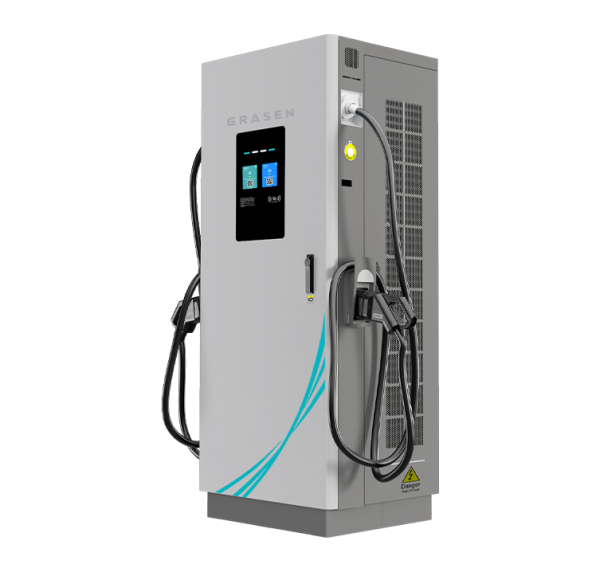As electric vehicles (EVs) continue to surge in popularity, the need for faster and more efficient charging solutions has become increasingly important. Traditional charging methods, such as Level 1 and Level 2 chargers, can be slow, especially for drivers who need to quickly recharge their EVs while on the go. Enter the DC Fast Charger—a game-changing innovation that is transforming the landscape of EV charging.
What is a DC Fast Charger?
A DC Fast Charger (also known as Level 3 charging) is a high-speed electric vehicle charger that uses direct current (DC) to deliver electricity to an EV’s battery. Unlike Level 1 and Level 2 chargers, which use alternating current (AC) and rely on the vehicle’s onboard charger to convert the power, DC Fast Chargers bypass the vehicle’s internal conversion system, delivering DC directly to the battery. This significantly reduces charging time, making them ideal for long-distance travel and high-demand environments.
How Does DC Fast Charging Work?
DC Fast Chargers work by delivering high-voltage DC power to an electric vehicle, typically ranging from 200 to 800 volts, depending on the model and configuration of the charger. The process is much quicker than traditional AC charging because the conversion from AC to DC takes place in the charging station itself, not in the car.
Most DC Fast Chargers are capable of providing a range of 60 to 80 miles of driving in just 20 minutes of charging, with some of the most advanced chargers reaching speeds that can recharge a vehicle up to 80% in as little as 30 minutes. This is a substantial improvement over Level 1 (which can take over 24 hours for a full charge) and Level 2 chargers (which typically charge an EV in 4 to 8 hours).
Types of DC Fast Chargers
There are two main types of DC Fast Chargers commonly found in public charging networks:
- CHAdeMO: Originally developed in Japan, CHAdeMO is one of the earliest DC fast charging standards. It is primarily used by Nissan, Mitsubishi, and other Asian manufacturers. CHAdeMO chargers typically deliver up to 50 kW of power.
- CCS (Combined Charging System): The CCS standard is more commonly used in Europe and North America, supported by major automakers such as BMW, Ford, and Volkswagen. CCS chargers can deliver higher power levels, typically ranging from 50 kW to 350 kW, with future iterations promising even faster charging speeds.
Benefits of DC Fast Chargers
- Rapid Charging: The primary advantage of DC Fast Charging is its ability to charge EVs much faster than other methods. This is particularly important for drivers who are on long road trips or need to quickly recharge during a busy schedule.
- Convenience: With the growing number of DC Fast Charging stations across highways, city centers, and commercial locations, it is becoming easier for EV owners to find quick charging points. This helps alleviate the “range anxiety” that many potential EV buyers experience.
- Supports Longer Trips: Thanks to the speed of DC Fast Chargers, EVs can be more viable for long-distance travel, as drivers can charge their vehicles during short stops.
- Future-Proofing: As battery technology improves and vehicles demand higher power levels, DC Fast Chargers are likely to evolve to meet these needs, offering even faster charging and ensuring that EV infrastructure keeps pace with advancements in vehicle technology.
Challenges and Considerations
While DC Fast Chargers offer many benefits, there are also challenges that need to be addressed:
- Cost of Installation: Setting up DC Fast Charging stations is significantly more expensive than installing Level 1 or Level 2 chargers. The infrastructure required to support high-power charging, along with maintenance costs, can be a barrier to widespread adoption.
- Energy Demand: DC Fast Charging stations require large amounts of electricity, which can put a strain on local energy grids if not properly managed. Balancing supply and demand will be critical as the number of EVs and charging stations increases.
- Vehicle Compatibility: Not all EVs are compatible with every type of DC Fast Charger. While the CCS standard is becoming more common, some older vehicles or models may only support certain types of charging systems, which could limit charging options for certain drivers.
- Overheating Concerns: Due to the high charging speeds, both the battery and the charging station’s infrastructure need to be carefully managed to avoid overheating, which can potentially damage the battery or the equipment. Cooling systems in the chargers and vehicles are necessary to mitigate this risk.
The Future of DC Fast Charging
The future of DC Fast Charging is bright. As electric vehicles continue to gain traction, the demand for fast, convenient charging options will only increase. Innovation in charging technologies, such as ultra-fast charging systems capable of delivering over 500 kW of power, is already on the horizon.
Moreover, the expansion of DC Fast Charging networks is critical to achieving the widespread adoption of electric vehicles. Many governments and private companies are investing heavily in creating charging infrastructure, and new policies and incentives are being introduced to make EVs more accessible to the average consumer.
